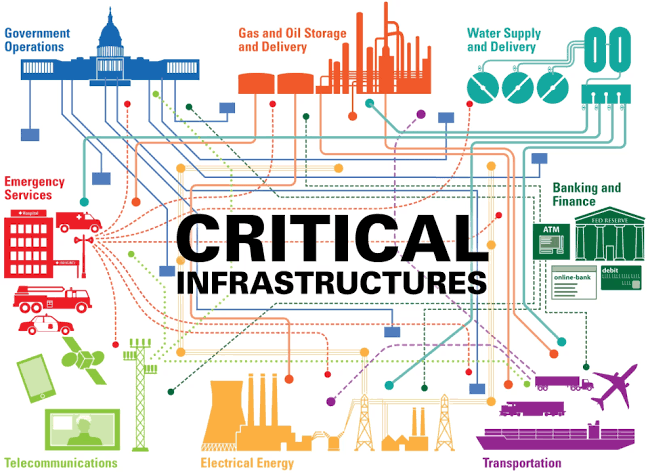In July 2025, cybersecurity is no longer just a concern for private companies or tech firms. It has evolved into a critical matter of national security. Nations around the world are becoming increasingly reliant on interconnected digital systems to operate essential services like power grids, transportation, healthcare, and financial institutions.
This increased reliance has introduced a growing number of vulnerabilities. Attacks on infrastructure can lead to mass blackouts, supply chain disruptions, economic turmoil, or even loss of life. As threats become more sophisticated, the role of cybersecurity in defending national infrastructure has never been more urgent.
Understanding National Infrastructure in a Digital Age
National infrastructure includes both physical and digital systems that are essential to a country’s functioning. This includes energy facilities, water treatment plants, air traffic control, rail networks, emergency services, hospitals, and government data centers.
In today’s hyper-connected world, nearly all of these critical systems are operated or supported by digital technologies. While digitization brings efficiency and automation, it also creates points of vulnerability. If exploited, these weaknesses can bring entire sectors to a standstill.
Cybersecurity is the layer of defense that keeps these systems functioning securely and resiliently against external and internal threats.
Increasing Threat of Cyberattacks on Infrastructure
Over the past decade, cyberattacks have become more aggressive and targeted. In 2024, several high-profile incidents demonstrated how hackers can cripple national systems. One of the most notable was a ransomware attack on a major European railway network that disrupted transport for days.
By mid-2025, attackers are using artificial intelligence and machine learning to identify and exploit weaknesses at an unprecedented speed. State-sponsored groups and cybercriminal organizations now target infrastructure with the intention to steal sensitive data, extort governments, or simply cause chaos.
The impact of such attacks goes beyond immediate disruption. They can erode public trust and even cause diplomatic conflict.
Role of Government in Cyber Defense
Governments now play a central role in protecting national infrastructure through legislation, oversight, and strategic investment. Many nations, including the United States, Canada, the UK, and members of the EU, have formed national cybersecurity agencies dedicated to defending critical systems.
In 2025, modern cybersecurity strategies are moving toward proactive defense rather than reactive containment. These include setting up early warning systems, investing in zero-trust architecture, and enforcing mandatory cyber hygiene standards across public and private sectors.
Governments also partner with technology companies to share threat intelligence and coordinate rapid response mechanisms in the event of a breach.
Importance of Private Sector Collaboration
A large portion of national infrastructure—especially in sectors like energy, telecommunications, and finance—is owned or operated by private companies. This means collaboration between the public and private sectors is essential for effective protection.
Governments cannot defend infrastructure alone. In 2025, cross-sector partnerships are becoming more formalized, with public agencies providing regulatory frameworks and private companies offering innovation and agility.
Joint exercises, shared cybersecurity drills, and information-sharing platforms are some of the tools now being used to ensure a united defense against potential threats.
Emerging Technologies and Their Security Implications
The integration of smart technologies such as IoT, 5G, and cloud computing into national infrastructure has significantly improved efficiency. However, these same technologies have also created new security challenges.
In 2025, the widespread deployment of smart grids, autonomous transportation systems, and remote-operated healthcare devices introduces thousands of access points. Without robust security, each of these can become an entryway for cybercriminals.
To mitigate this, experts now emphasize “secure-by-design” practices—developing systems with built-in cybersecurity protocols from the outset, rather than adding them as an afterthought.
The Human Element in Cybersecurity
While technology is a core component of cybersecurity, human behavior often represents the weakest link. Many breaches in infrastructure systems begin with phishing emails, poor password practices, or lack of training.
In 2025, education and awareness programs are key components of national cybersecurity strategies. Governments and businesses are investing heavily in workforce training, not just for IT professionals but for all personnel who interact with sensitive systems.
Regular drills, simulated attacks, and certifications are being used to ensure that staff can recognize threats and respond appropriately.
Building Resilient and Redundant Systems
Even the most secure systems can be breached. That’s why resilience and redundancy are now fundamental to national infrastructure planning. The ability to recover quickly and maintain service during an attack is just as important as preventing one.
Cyber resilience involves having backup systems, disaster recovery protocols, and incident response plans in place. In 2025, cloud-based recovery solutions, AI-driven monitoring tools, and encrypted backups are being deployed more widely.
Some nations are now also separating their most critical infrastructure networks from the open internet—a practice known as network segmentation—to limit the spread of potential attacks.
Global Cooperation and Policy Frameworks
Cyber threats do not respect national borders. An attack launched in one country can affect multiple others through interconnected systems and global supply chains. Therefore, international cooperation is vital.
In 2025, multinational bodies such as the UN, NATO, and the OECD are pushing for more unified cybersecurity frameworks. These include agreements on cyber warfare norms, extradition treaties for cybercriminals, and joint response protocols.
Global collaboration ensures that nations can respond quickly and collectively when a serious threat arises, reducing the impact and improving chances of attribution.
Conclusion: Securing the Backbone of Modern Society
The importance of cybersecurity in protecting national infrastructure cannot be overstated. As digital systems become the backbone of modern society, securing them is not just a technological necessity but a matter of national sovereignty and public safety.
In 2025, the conversation has moved beyond whether cybersecurity is needed—it’s now about how to implement it effectively, inclusively, and sustainably. Governments, private companies, and individuals must work together to strengthen defenses, reduce vulnerabilities, and stay ahead of evolving threats.
Investing in cybersecurity is investing in national resilience. Without it, modern infrastructure is simply too exposed to ignore.



